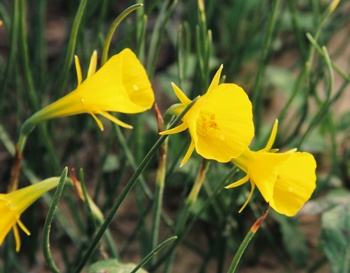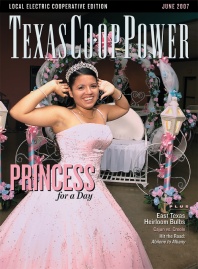In early spring, a typical drive through the rural East Texas countryside will feature plenty of flowers in bloom, not only in present-day yards, but also in ghost yards where old houses once stood.
The flowers have commonly outlived the people who first planted them, by several generations in some cases. They have survived transplantation from old homesteads to new, family to family, neighbor to neighbor, soil to soil. Some of the oldest came from the Old South to Texas after the Civil War aboard the wagons of families looking for fresh prospects, and they remain today an apt symbol of the stubborn optimism of those settlers.
The early bloomers come just when they’re needed, as the gray wool of winter wears threadbare and the air begins to smell of damp earth, reminding us that spring is alive and well in the ground under our feet. Thriving on neglect, these lost beds of narcissus, daffodils, hyacinths and irises not only please our eyes and noses every spring, but also mark where ancestral lives were once lived. Later in the year, as summer edges toward fall, several old varieties of lilies will bloom, including the blushing one the old timers called Naked Lady, leggy and immodest among her more pious sisters.
If these bulbs are inadvertently gouged from some overgrown former dooryard by road construction machinery, ripped apart and crushed under bulldozer tracks, they simply pop up with the spring grasses wherever the machines happen to leave them, as flower-bedecked road ditches all over East Texas will confirm.
Something About a Red Tulip
Chris Wiesinger caught bulb fever when he was a youngster. He saw a picture of a beautiful, bright red tulip on the label of a cardboard box, but inside the box were little dirt-brown things that looked to him like rocks. If bright red flowers came from such weird looking sources, he wanted to see it for himself, so he planted one in the yard of his family’s Bakersfield, California, home.
He now recalls, “A few months went by, and that spring Bakersfield got good rains, which is not always the case there. I had totally forgotten about the rock I planted, but one day I looked out the window and saw this bright red thing outside, and there it was, a real tulip just like the picture on the box. It only lasted a day or so, and it never came up again. But I thought, this thing that obviously had life in it should have continued living, and I was curious to know why it hadn’t.”
Such are the kinds of childhood experiences that inspire careers. From the red tulip moment on, as he grew up, young Wiesinger remained interested in growing things and hired himself out to do gardening work for neighbors. Meanwhile, he and his family had moved back to their home state of Texas and, not surprisingly, when it came time for college, Chris enrolled at Texas A&M majoring in horticulture.
As his college career progressed toward graduation, one of his senior horticulture classes required him to write a hypothetical business plan.
“I wrote a plan based on collecting, propagating and selling heirloom flower bulbs specifically adapted to the South.”
The plan not only impressed the professor, but evidently convinced the student as well. After graduating in the spring of 2004, Wiesinger decided to put his business plan into action and founded The Southern Bulb Company, along with fellow A&M graduates Brad Gaultney and Ben Arcuni.
The Southern Bulb Company is located in East Texas, near a little crossroads community called Golden, just northwest of Mineola in Wood County. The farm is on the kind of deep, sandy soil once favored in the area for truck crops, sweet potatoes and peanuts. Tucked away behind a grove of oaks just off U.S. Highway 69, Chris and his partners tend a large field of long rows bedded in the tan soil where the bulbs are set. Looking across the field eastward to the bordering woods, the scene could be an East Texas farm of a hundred years ago, but at the west end of the field are an implement shed with a bright blue tractor, a packing and shipping shed, various farm machinery, and cold-frame beds tented with plastic sheeting.
I visited the farm on a bone-chilling day this past January, just after a wintry mix of sleet and freezing rain had crusted the ground. The idea of spring flowers seemed a distant, abstract concept, yet oddly, there were a couple of specimens of hyacinths in exposed outdoor beds that had bloomed before the freeze but were now glazed in a delicate coating of ice. They looked perfectly preserved but, of course, were as dead as hammers. (These old flowers are amazingly hardy, but they do have their limits.)
We walked the bedded rows of the main field, which showed nary a sign of green; in fact, the soil was hard frozen. (Bulbs actually need a certain number of “chill days.”) Wiesinger pointed out which rows were planted with what bulbs and talked a little about the soil characteristics and his cultivation techniques.
“We don’t use any chemical fertilizers. This field used to be an old hay meadow, so the soil wasn’t too badly depleted. The only thing we’ve done is add some potash to raise the pH level because the soil in this area tends to be acidic.”
Continuing the tour, Chris showed me indoors, a welcome break from the blue norther. From a clump of bulbs he pulled a typical narcissus bulb, which looked like a small, dirty onion. I was surprised to learn that a single bulb can be divided into several pieces and each piece propagated into a new plant, as long as the individual piece retains enough of the reproductive tissue at the base of the bulb. He borrowed my pocketknife and demonstrated by cutting a bulb into sections lengthwise.
He then turned to a grouping of plastic nursery pots containing blooming paperwhites, one of the most popular types of narcissus. He lifted one pot with its clusters of small, creamy white flowers to his nose and inhaled the fragrance.
“At one time there were over 200 varieties of paperwhites on the market, but now there are only about five. These are a particularly sweet-smelling old variety,” he said.
A Recurring Theme
From narcissus, the subject came back to tulips.
“I’m hoping by early this fall we’ll be able to offer a very special variety of heirloom tulip that will naturalize well, from Northeast Texas all the way down to the Austin area.”
When Wiesinger uses the word “naturalize,” he means the flower will adapt well and develop a perennial habit, returning every year from the same bulbs. Tulips are classified as perennials, but care must be taken to match the right bulbs with the right climate zone and growing conditions to get a yearly return.
Tulips apparently have a special power over their admirers, and not just a kid marveling at a blooming rock. In Holland in the early 1600s, a peculiar phenomenon now referred to as “tulip mania” swept the country. Tulip bulb trading grew from a fad to outright hysteria, soon leading to fraud and corruption. At its height, bulbs were sold for outrageous sums and exchanged for land, prized livestock and houses. The story goes that a good trader could earn 60,000 Dutch florins a month. (The average yearly income at the time was 150 florins.)
Eventually the craze reached a fever pitch and some traders began to sell bulbs that had only just been planted, or even bulbs they intended to plant at some future date, in effect selling tulip futures contracts. But, as these things usually go, in 1636, the bottom fell out, and thousands of Dutch, including businessmen and dignitaries, were financially ruined.
Wiesinger’s goal is a bit more reasonable: to make an honest living doing work he loves, and to help people share his passion for beautiful heirloom flowers.
Of his original inspiration he says, “I guess that red tulip sort of stuck with me. If we’re able to offer the one I’m hoping for this fall, that’ll be full circle.”
Southern Bulb Company (www.south ernbulbs.com) is served by Wood County Electric Cooperative.
Jim Anderson, a frequent contributor, lives on his family’s farm near Paris, served by Lamar Electric Cooperative, where bulbs planted by his ancestors still bloom every spring.


